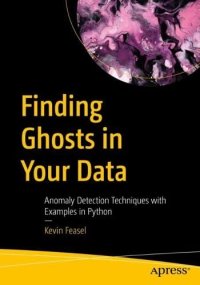
Ebook: Finding Ghosts in Your Data: Anomaly Detection Techniques with Examples in Python
Author: Kevin Feasel
- Genre: Computers // Algorithms and Data Structures: Pattern Recognition
- Tags: Outlier Analysis, Anomaly Detection, Gestalt, Robust Statistics, Interquartile Range, Mahalanobis Distance, Changepoint Detection, Exponential Smoothing, Time Series Anomaly Detection, ARMA, ARIMA, Anomaly Detection as a Service, Anomaly Detection Principles and Algorithms, Anomaly Detection: Techniques and Applications, Python, Outlier and Anomaly Detection, Multivariate Anomaly Detection, Azure Cognitive Services Anomaly Detector
- Year: 2022
- Publisher: Apress
- City: New York
- Edition: 1
- Language: English
- pdf
Discover key information buried in the noise of data by learning a variety of anomaly detection techniques and using the Python programming language to build a robust service for anomaly detection against a variety of data types. The book starts with an overview of what anomalies and outliers are and uses the Gestalt school of psychology to explain just why it is that humans are naturally great at detecting anomalies. From there, you will move into technical definitions of anomalies, moving beyond "I know it when I see it" to defining things in a way that computers can understand.
The core of the book involves building a robust, deployable anomaly detection service in Python. You will start with a simple anomaly detection service, which will expand over the course of the book to include a variety of valuable anomaly detection techniques, covering descriptive statistics, clustering, and time series scenarios. Finally, you will compare your anomaly detection service head-to-head with a publicly available cloud offering and see how they perform.
The anomaly detection techniques and examples in this book combine psychology, statistics, mathematics, and Python programming in a way that is easily accessible to software developers. They give you an understanding of what anomalies are and why you are naturally a gifted anomaly detector. Then, they help you to translate your human techniques into algorithms that can be used to program computers to automate the process. You’ll develop your own anomaly detection service, extend it using a variety of techniques such as including clustering techniques for multivariate analysis and time series techniques for observing data over time, and compare your service head-on against a commercial service.
What You Will Learn
Who This Book Is For
For software developers with at least some familiarity with the Python programming language, and who would like to understand the science and some of the statistics behind anomaly detection techniques. Readers are not required to have any formal knowledge of statistics as the book introduces relevant concepts along the way.
The core of the book involves building a robust, deployable anomaly detection service in Python. You will start with a simple anomaly detection service, which will expand over the course of the book to include a variety of valuable anomaly detection techniques, covering descriptive statistics, clustering, and time series scenarios. Finally, you will compare your anomaly detection service head-to-head with a publicly available cloud offering and see how they perform.
The anomaly detection techniques and examples in this book combine psychology, statistics, mathematics, and Python programming in a way that is easily accessible to software developers. They give you an understanding of what anomalies are and why you are naturally a gifted anomaly detector. Then, they help you to translate your human techniques into algorithms that can be used to program computers to automate the process. You’ll develop your own anomaly detection service, extend it using a variety of techniques such as including clustering techniques for multivariate analysis and time series techniques for observing data over time, and compare your service head-on against a commercial service.
What You Will Learn
- Understand the intuition behind anomalies
- Convert your intuition into technical descriptions of anomalous data
- Detect anomalies using statistical tools, such as distributions, variance and standard deviation, robust statistics, and interquartile range
- Apply state-of-the-art anomaly detection techniques in the realms of clustering and time series analysis
- Work with common Python packages for outlier detection and time series analysis, such as scikit-learn, PyOD, and tslearn
- Develop a project from the ground up which finds anomalies in data, starting with simple arrays of numeric data and expanding to include multivariate inputs and even time series data
Who This Book Is For
For software developers with at least some familiarity with the Python programming language, and who would like to understand the science and some of the statistics behind anomaly detection techniques. Readers are not required to have any formal knowledge of statistics as the book introduces relevant concepts along the way.
Download the book Finding Ghosts in Your Data: Anomaly Detection Techniques with Examples in Python for free or read online
Continue reading on any device:

Last viewed books
Related books
{related-news}
Comments (0)